The NAD Masters Series M66 Streaming DAC/preamplifier ($6,999 – buy at Crutchfield) is NAD’s flagship stereo preamp, offering features and connectivity well beyond NAD’s other preamplifiers and most audiophile components made by competitors. The NAD M66 earns its high-end credentials with its top-tier DAC chip, advanced signal processing options, BluOS streaming, and fully balanced internal circuitry. (Bluesound, BluOS, and NAD are all part of Canada’s Lenbrook Group.)
Since its start in 1972, NAD has been known for audio equipment that performs beyond its price point. Countless audiophiles have started their journey with NAD products in their early systems. Today, NAD’s Masters Series products compete with the big boys without the big prices. Can the NAD M66, at nearly $7,000, meet that promise? Let’s find out …
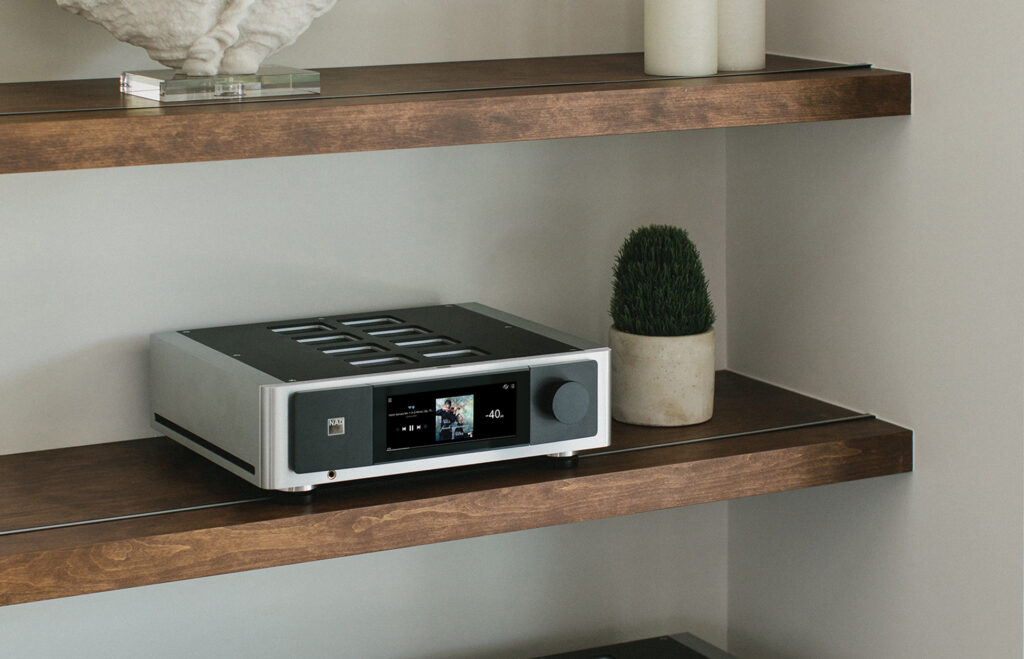
What Makes the NAD M66 Stereo Preamp So Special?
- The M66 is unusually function-rich. Among its hardware features, the M66 includes:
- A preamp with Analog Direct option, in which analog signals are never converted to digital
- A phono stage with moving-magnet and moving-coil inputs and a switchable 15 Hz infrasonic filter
- Balanced and single-ended line-level analog inputs, an HDMI-ARC input for TV sound; and many digital inputs
- Six channels of digital-to-analog conversion (two main and four subwoofer channels)
- A Roon-Ready BluOS internal streamer with WIFI, Ethernet, and Bluetooth inputs, including high-quality Bluetooth codecs, such as LDAC and aptX HD, as well as AAC for Apple users
- Balanced and single-ended analog outputs for two main speakers and four subwoofers
- An ADC (analog-to-digital converter) so analog sources can use the M66’s extensive digital processing
- There’s room for expansion and possible future upgrades. Since 2010, NAD has used its MDC cards to expand the capabilities of its products. For example, older NAD preamps could add streaming with an MDC card – essentially, a Bluesound Node on a card. The M66 accepts NAD’s second generation, MDC2, which could extend its lifetime by adding new functions.
- Dirac’s advanced room correction is included. The NAD M66 is capable of room correction and comes with licenses for both Dirac Live and Dirac Bass Control (about which I’ll say more later).
- The flagship ESS Sabre ES9038PRO DAC chip in the M66 is used in many of today’s best high-end DACS. Its eight channels are dedicated to the main speakers, with subwoofers handled by a pair of TI PCM5122 chips. Conversion of analog sources to digital, when chosen, is via the ES9822PRO ADC chip, also with impressive specs. While the quality of digital conversion depends on more than just the chip, using top-drawer chips is a great place to start.
- The NAD M66 supports PCM Audio up to 24-bit/192 kHz resolution, with full MQA decoding. While 192 kHz won’t win the PCM specs race, it’s more than enough for excellent sound, and it can be argued that any higher resolution is unnecessary. To play DSD, convert to PCM or use your SACD player’s analog outputs.
- The M66 includes NAD’s Dynamic Digital Headroom technology, which prevents digital overloads generated during interpolation in DAC circuitry. This gives cleaner reproduction of transients, eliminating the sonic hash sometimes heard in percussive sounds or other high-amplitude peaks.
- In Analog Direct mode, the M66 uses a relay-switched resistor array for volume control. Besides giving precise control of volume and channel balance, this feature avoids the potential noise, distortion, and tracking error of potentiometers. In digital mode, the ESS DAC chip’s internal volume control is used instead.
- The enclosure has a seven-inch touchscreen and NAD’s handsome Masters Series casework. It attractively blends with other gear, including NAD Masters Series products, past and present.
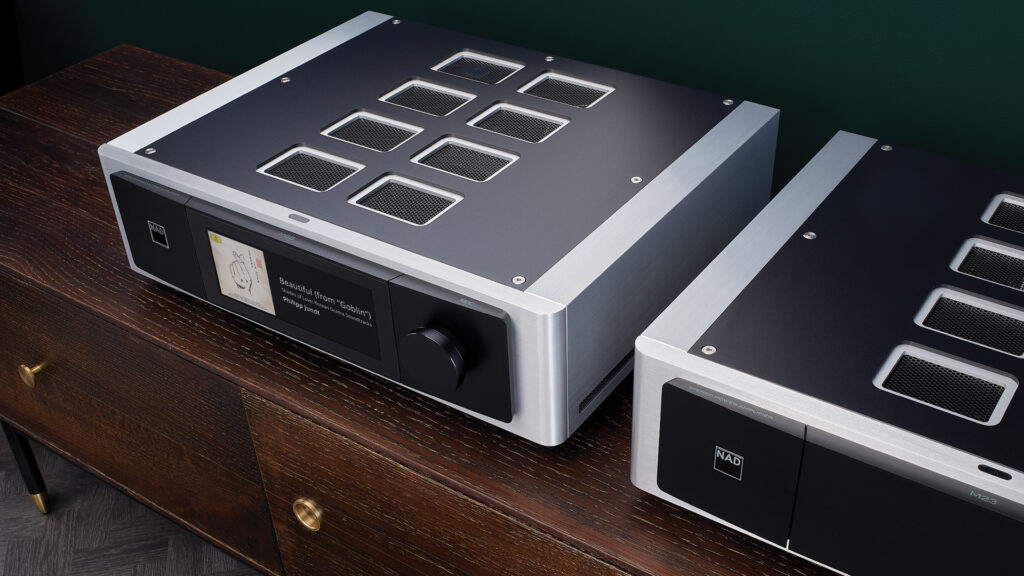
Why Should You Care About the NAD M66 Preamplifier?
While NAD has taken great pains in the analog design of the M66, it’s the unique digital features that I suspect will attract buyers. The combination of top-shelf DAC and ADC chips, along with Dirac Live (DL), Dirac Live Bass Control (DLBC), and four subwoofer outputs to support the latter, make this product unique in the audiophile world. For the owner who embraces digital and yet still loves LP and/or tape, the M66 offers phono inputs and an Analog Direct circuit path, or users can instead digitize analog signals with the M66’s ADC to take advantage of Dirac Live. Besides the M66, the only thing needed to build an outstanding audiophile system is a pair of powered speakers (or a power amp and passive speakers). For any audiophile shopping around this price point, the M66 offers excellent sound and state-of-the art room correction, all in a handsome, comprehensive package.
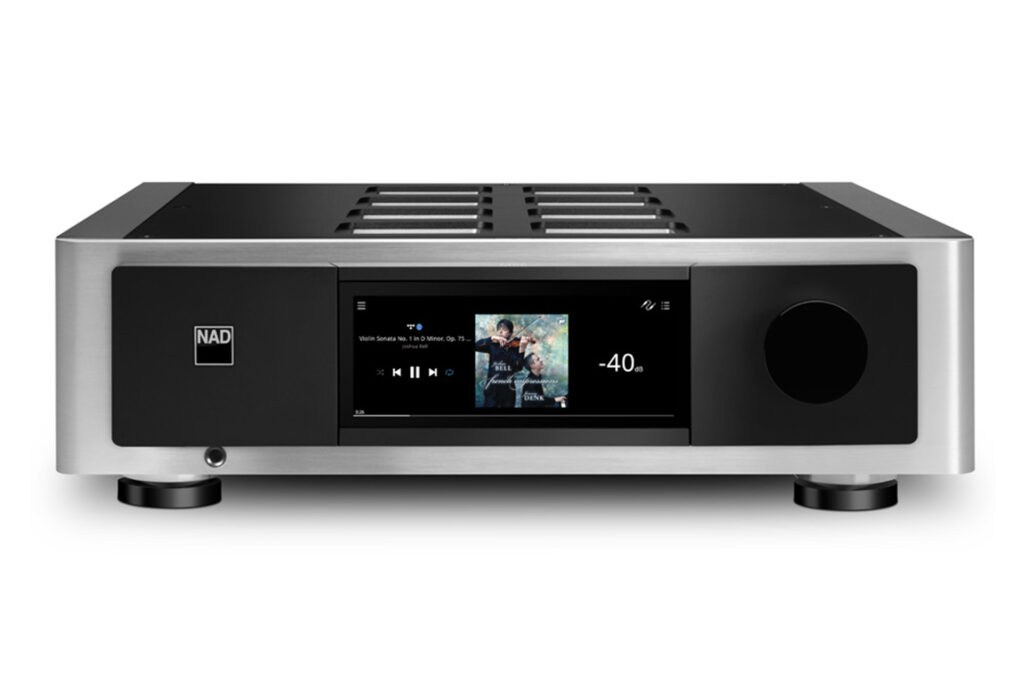
Some Things You Might Not Like About the NAD M66 Streaming DAC Preamplifier
- The NAD M66 may not have enough gain for your setup. The M66 has less gain than some preamps and, when Dirac Live is on, gain is reduced by up to eight dB for digital headroom. With tone controls on (even if set flat), another six dB is lost. Driving my moderately efficient speakers via amplifiers with 19 dB of gain (less than most), the M66’s volume control was maxed out on some tracks, and occasionally I would have liked more volume. It sometimes helped to turn on Roon’s volume leveling or the M66’s own replay gain, though likely the best solution is using more efficient speakers or a higher-gain amplifier, such as NAD’s own M23.
- Dirac Live room correction is powerful but poorly documented. This is more an issue with Dirac than NAD, but it’s unfortunate that Dirac must be learned by trial and error and by reading online material that’s not always current.
- Some interface choices made by NAD had me scratching my head. For example, you can set the display screen to time out, but the interval is always 15 minutes, too short for me. The remote does little. I used Roon, the BluOS app, and the touchscreen instead. And the “now playing” screen shows neither volume nor digital audio resolution, though when you change volume, the new level is displayed briefly.
- There’s no home-theater bypass feature. For those who hope to use the NAD M66 as part of a combined audio and home theater system, this will be an important omission. NAD says that, although not part of the original feature set, Home Theater bypass is under development as part of a future firmware update.
- Dirac Live Active Room Treatment (ART), promised for the M66, is not yet here. This next-generation development by Dirac Research is designed to configure combinations of main speakers and subs to support one another and to cancel lingering room reverberations, improving bass clarity and impact. It sounds great in theory, but its arrival date on the M66 is unknown, and using ART will require purchasing a license.
- The NAD M66 firmware has some bugs, and the timeline for fixing them is indefinite.An issue I reported (and NAD confirmed they are working to fix) can cause the M66 to play up to 30 dB louder than expected when waking from standby, posing a risk to your ears and your speakers both. I found that adjusting the volume control after the M66 wakes, but before playing music, will align the actual volume with the displayed volume, which the M66 sets automatically to a safe level.
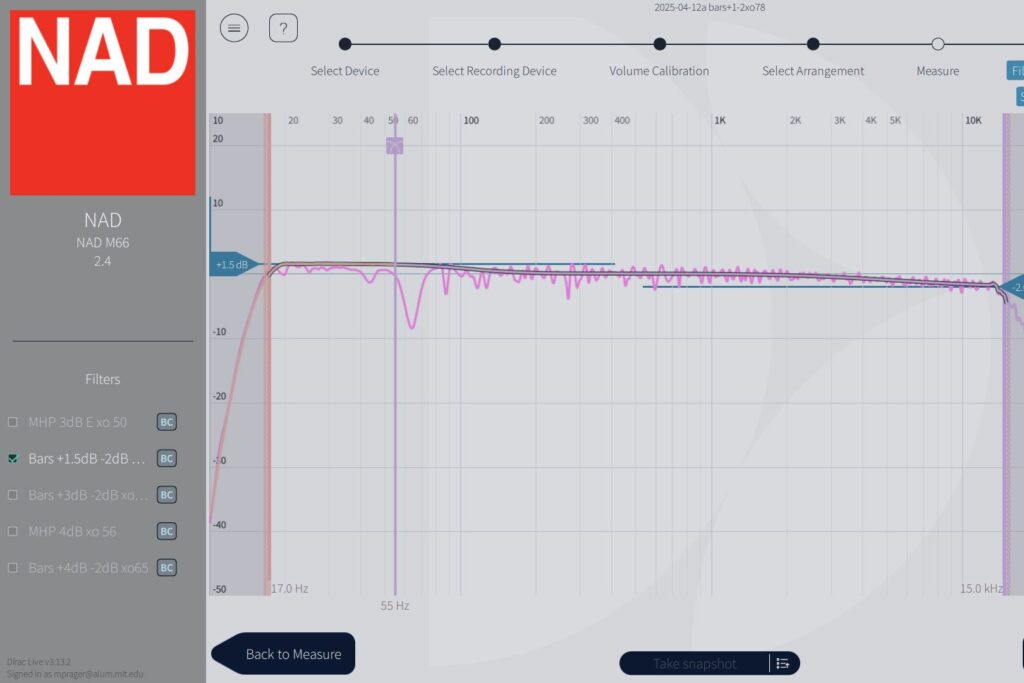
Setting up the M66 with Dirac Live and Bass Control (a Technical Sidebar)
Why room correction? The purpose of digital room correction (DRC) is to correct room-caused sonic problems – mainly bass peaks and nulls – at the listening position. When done properly, DRC results in smooth bass response, with no missing notes or boomy echoes. DRC programs like Dirac Live (DL) also generate digital crossovers and make phase and level adjustments to better integrate subwoofers and main speakers. Who can benefit from this? I’d say, almost any audiophile whose system is in a domestic room.
Whether to also apply DRC to frequencies above roughly 500 Hz is a matter of personal preference and a topic frequently debated. I’ve found it sometimes can flatten speaker frequency response and improve left–right matching, which benefit both timbre and imaging.
A key feature of the M66 is its support for Dirac Live Bass Control (DLBC), an add-on to DL that on the M66 can optimize up to four subs and two main speakers working together. Simultaneously optimizing all bass sources is a significant step forward in DRC, since speakers and subwoofers interact not just with the room but also with each other. In contrast, competing systems that optimize one or two speakers at a time can’t fully address nulls caused by speaker interactions, and thus may not equal the results of a program like DLBC. To apply DLBC, a hardware device (preamplifier) must be able to control each speaker individually, which the NAD M66 does through its six speaker outputs (two mains and four subwoofers).
From here on, I’ll use “DL” and “DLBC” to refer to the individual software components, and “Dirac” to mean DL with DLBC as used on the M66.
Here’s how I set up Dirac with the NAD M66. After downloading software from Dirac, I connected a UMIK-2 calibrated microphone to a laptop and launched Dirac Live. The software found the NAD M66 on my home LAN, and automatically recognized the DL and DLBC licenses that come with the preamp. If licensed, DLBC integrates into DL as an option for the bass frequencies. Using the BluOS Controller on the laptop, I selected the “four subwoofers” configuration. Returning to the Dirac Live application, I was guided to make multiple measurements of the six speakers in turn, after which the software graphed the measurements onscreen.
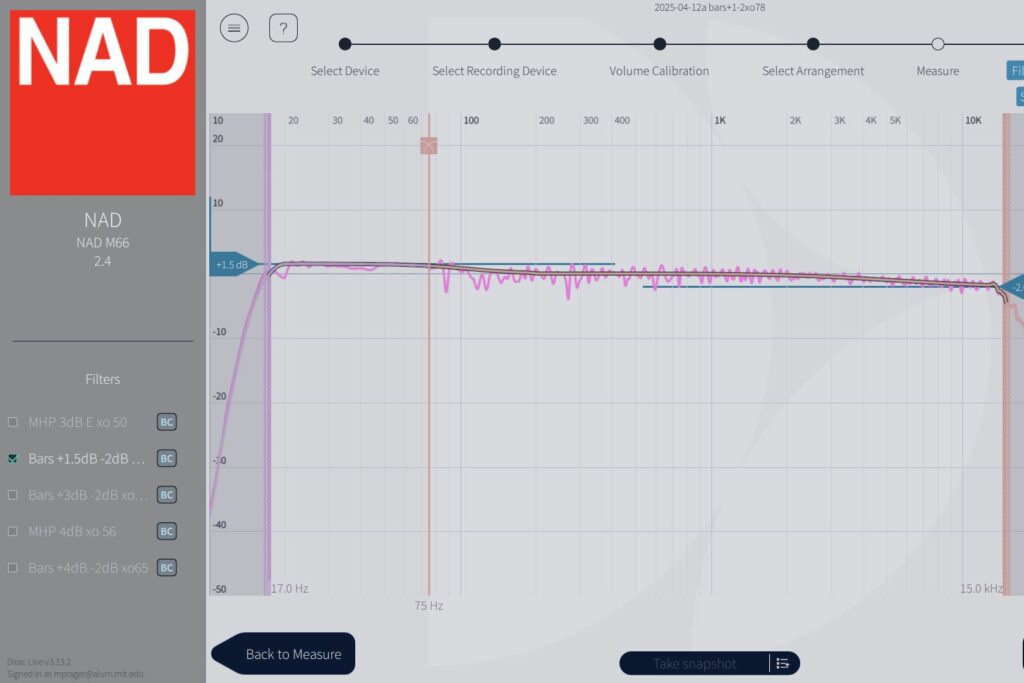
The next step was choosing a target curve, which defines the frequency response you want to hear at the listening position. Psychoacoustic studies show that a flat target curve sounds bright and hard; users typically find a bass boost and treble cut of a few decibels each to give more pleasing sound. NAD’s default target curve had too much bass boost for me, so I decided to design my own.
After trying the older Dirac interface, which requires moving numerous graph points around with a mouse, I switched to their new interface, which is much easier to use. In this, you drag low- and high-frequency sliders, which Dirac calls bars, to set bass and treble levels respectively. (I liked this but wished I could change the low-frequency boost’s fixed turnover frequency of 100 Hz. To my ears, using 200 Hz can give male vocals and bass instruments a bit more natural life. This can be accomplished in the older interface, but it’s more tedious.) I wound up with three similar target curves, each with a -2 dB cut in the treble and with bass boosts of +1.5, +3.0, and +4.0 dB. To be clear, the boost and cut are not from the speakers’ own frequency response, but rather from perfectly flat response at the listening position, a condition that never exists and that very few audiophiles would want if offered it.
The next step in Dirac (as any DRC system) is filter computation. Here, the program generates code (filters) to digitally adjust amplitude and phase of the audio signal at certain frequencies during playback. Calculating filters for one or two speakers is relatively simple, but in the bass, where six speakers and room reflections interact, the task is computationally demanding. Because the number of possibilities is astronomical, DLBC uses a guided random search method (a neural network), a process that took about 35 seconds on my i7 laptop. Once an optimal filter is found, the expected frequency response from it is graphed on the screen, along with the target curve and measurements. If the user is satisfied with the filter, it can be saved with a descriptive name in any of the M66’s five filter slots. If not satisfied, the user can make changes and try again. Note: any possible delay isn’t an issue with your laptop per se as much as it is Dirac crunching data in Sweden.
The effectiveness of DLBC can depend on the user’s choice of subwoofer crossover frequency and, to a lesser degree, on the random numbers that occur in the particular run. (See figures for an example.) To account for this, I ran Dirac for each target curve on a sequence of crossover frequencies (typically 55, 60, 65, 70, and 75 Hz), examining expected response of each case. After finding the crossover frequency that gave best frequency response, I ran Dirac several times with that crossover frequency, which sometimes could find even better results. Finally, I saved the best filter to an M66 slot for use when playing music.
Listening to the NAD M66 Streaming DAC Preamplifier
The first NAD M66 I received had a dead display, which made it unusable. This review is of its replacement, which worked fine. I couldn’t exercise every feature of the M66, but I tried to explore many. A short trial of Wi-Fi (instead of my usual Ethernet) worked fine. When I plugged a USB hard drive into the M66, BluOS indexed its audio files, and I could play them as expected. Connecting an Auralic Aries G1 streamer to the M66’s AES3 input gave sound indistinguishable from using the M66’s internal streamer. Audio sent to the M66 through LDAC (lossless) Bluetooth was the best Bluetooth audio I’ve heard, but I still view Bluetooth as a convenience feature. Finally, I tried the Analog Direct signal path by feeding the Aries’ output to a Topping DX9 DAC and then into the M66’s balanced analog input. The sound was fine that way, too, though I missed the subwoofers and DRC.
In my more extensive listening, Roon was the source, the M66’s balanced outputs fed Orchard Audio Ultra-Premium monoblocks and Janszen Valentina speakers (read my review), the M66’s sub outputs drove four SVS SB-3000 subwoofers (read my review), and Dirac was engaged. Unfortunately, A–B comparisons with my reference Anthem STR Preamp (read Andrew Dewhirst’s review) were impractical, as the setup would take hours.
Steve Wonder’s hit “Sir Duke” from Songs in the Key of Life shows its age sonically, but the 24/192 remaster is far better than the early CD transfer. With the NAD M66 and Dirac, bass was solid and even, with no missing or weak notes. Cymbals were a bit splashy, which I chalk up to the recording, but that splashiness was not exaggerated by the NAD M66, so the result was enjoyable, non-irritating sound. Wonder’s vocals sounded natural, with every word clear, and that clarity persisted as the mix got loud and busy. Imaging and depth were excellent. Particularly in the bass, I thought the track sounded the best I’ve heard it, with its lively energy really coming through.
Alec Frank-Gemmill’s 2024 recording of the Mozart Horn Concertos (24/96, Qobuz) is delightful for both musicianship and sonics, with Frank-Gemmill playing with vigor and freedom. In the final movement of the second concerto, there is a sudden horn figure at about 1:10 that demonstrated the excellent dynamics with the M66 at the helm. Throughout the movement, the NAD M66 did a beautiful job rendering the French horn’s timbre and dynamics convincingly.
When we played Roberta Flack’s “Killing Me Softly” from the album Killing Me Softly, a member of my listening panel said it was a favorite that he’d been listening to for 50 years, and he’d never heard it sound better. He was especially impressed by the clarity of the vocals, as he could understand every word. He also liked that the low drum stayed firmly towards the right of the soundstage, as recorded, despite the M66’s running the subs in mono. To me, Flack’s voice had an easy, human quality, and the artificial echo on the backup vocals was part of the fun. The electric piano was spread across the soundstage. All in all, this Grammy-winning hit sounded great.
Every audiophile and music lover who heard the M66 in my system praised it. The most frequent comments were how great the bass was and how the subs could not be localized. The next most frequent comments were about naturalness of the sound, which was my favorite characteristic of the M66.
Will the NAD M66 Streaming DAC Preamplifier Hold Its Value?
The biggest unknown in used pricing of the NAD M66 right now is gyrating U.S. tariff policy. The NAD M66’s US MSRP increased from $5,499 when I got the review unit to $6,999 at the time I write this (mid-May), and prices of units on the used market have climbed correspondingly. NAD told me that these MSRP increases were largely due to tariffs, and that prices may go back down if the U.S. lowers tariffs on Chinese-made electronics. Therefore, retained value of an NAD M66 will depend partly on tariff levels when you buy and sell.
That aside, I’d expect any NAD Masters Series component to hold value better than an average piece of audiophile gear. Performance is exemplary, and the consistent styling means products don’t look out-of-date quickly. NAD has many dealers, so audiophiles have plenty of chances to hear and fall for the M66.
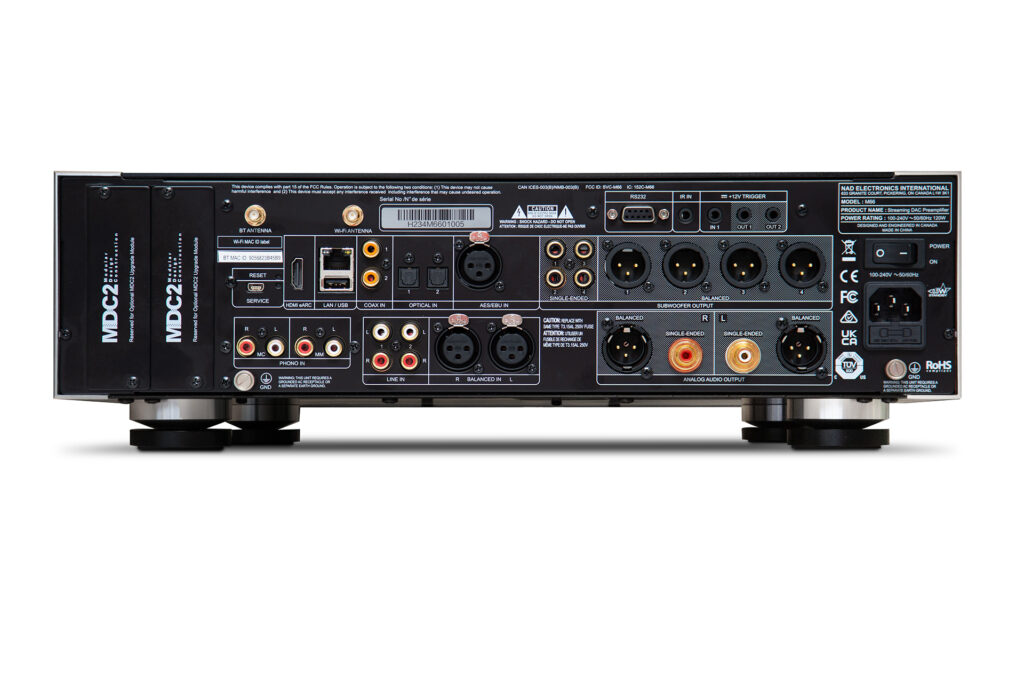
What is the Competition for the NAD M66 Streaming DAC Preamplifier?
An obvious competitor is the Anthem STR Preamplifier (buy at Crutchfield), a reference preamp owned by three of our reviewers, including me. The Anthem STR offers a lot for $4,299.99, including great looks, an excellent user interface, built-in DAC, plenty of gain, Anthem Room Correction (ARC), tone controls, and two subwoofer outputs. However, I found the NAD M66 a bit more transparent and natural-sounding, lacking the slight upper-midrange forwardness I hear from the Anthem. The four independent subwoofer outputs are another plus for the M66. If you want great bass from multiple subwoofers and don’t want to spend hours on manual tweaking, I think you’ll find DLBC more effective than ARC as they both stand now.
I didn’t find any competing stereo preamps that match the M66’s four subwoofer outputs, but some AV processors and receivers have the feature. The Trinnov Altitude 16 processor ($19,500) uses Trinnov Optimizer software, considered among the best audio DRC around. Storm Audio processors, such as the ISP Core 16 ($13,999) and ISP Evo (starting at $18.999), support Dirac Live, Dirac Live Bass Control, and Dirac Live Active Room Treatment. Indeed, Dirac Research chose Storm Audio processors to receive ART before any other processors.
Several Marantz and Denon AV receivers support four subwoofers and come with Audyssey MultEQ XT32 and SubEQ HT standard. The models also support Dirac Live and Dirac Bass Control if the owner buys Dirac licenses. Among the models are the Marantz Cinema 40 ($3,500), Marantz Cinema 30 ($4,500), Denon AVR-A1H ($6,499), and Denon AVR-X6800H ($3,499).
Because I’ve never heard any of those Trinnov, Storm Audio, Marantz, or Denon devices, nor have I used Audyssey, I can’t say more about those products. I can only pass on my usual advice: Get a home trial before you commit if you think these components might be for you.
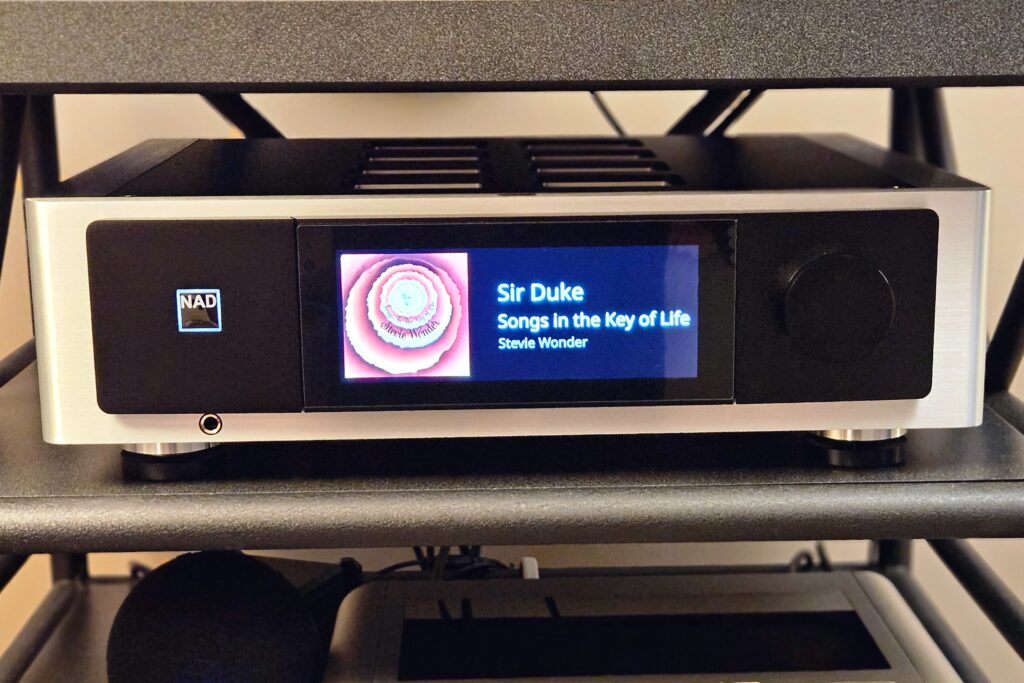
Final Thoughts on the NAD M66 Streaming DAC Preamplifier …
When I first hooked up the NAD M66 (buy at Crutchfield), I was put off by its quirky interface, the sketchy documentation of its Dirac features, and various minor bugs. As I continued listening, I eventually relaxed into the NAD M66’s excellent musical sound. Bass from DLBC was the most even I’ve achieved in 25 years of running DSP with multiple subs. This made it much more enjoyable (and possible) to follow interesting bass lines. Midrange and treble had a slightly gentle and natural quality that I associate with the best components. I heard plenty of natural detail, but nothing hyped or shouty. Two listening panel members in their 40s mentioned the non-fatiguing sound – a perception I was happy to have seconded by younger but quite experienced ears.
Though it’s been months since I had the SPL Director 2 and Benchmark LA4 preamps available, I’d say that the NAD M66 offers a good measure of the immediacy and sweetness that makes those preamps so enjoyable. As to imaging and soundstaging, the NAD M66 did not disappoint.
I’ve sometimes found DRC systems to introduce subtle (or occasionally, not-so-subtle) artifacts, but with Dirac Live on the M66, I didn’t detect sourness, harshness, or similar changes in hard-to-reproduce instruments like violin. When occasionally I thought something was amiss, I turned off Dirac, but when I turned it on again, I didn’t hear any problem. I concluded that if there are negative side effects, they are really hard to hear. I am happy that audio DSP continues to improve, and here it’s complemented by NAD’s careful design of the preamp as a whole. For tonality and lack of listening fatigue, the M66 gets high marks in my book, with or without Dirac engaged.
To weigh value, one might compare the NAD M66’s price to the total costs of a high-end preamp, phonostage, audiophile streamer, Bluetooth receiver, DAC, and headphone amp, with the added costs of Dirac Live and Bass Control licenses. In my system, which is based around a DAC-preamp with DRC, the NAD M66 replaced gear with combined MSRP of about $8,700, and it improved the sound quality to boot.
The NAD M66 offers capabilities that, to my knowledge, no other audio component under $10,000 provides. Its many features and few quirks mean that if you are considering the M66, you should insist on an extended home trial, so you can get to know the M66 and Dirac and see if the features important to you are implemented the way you want. If they are, I expect you’ll enjoy the NAD M66 very much and for a very long time.




Off the top of my head, I believe this is the first audio component review I’ve read that mentions the impact of these !@#$% tariffs. I’ve been intrigued by this and other NAD offerings for some time (as I believe DSP is undeniably the best way to deal with goofy rooms) but ultimately I went the Lyngdorf route. For roughly the same price, Lyngdorf’s TDAI-3400 offers comparable functionality and more flexibility than I can get my head around, all in a very user friendly package that never feels intimidating. RoomPerfect only offers two subwoofer connections rather than DLBC’s four, but does an impressive job that doesn’t leave me wanting for anything, and as a bonus you get a shockingly good 200 w/ch amplifier built-in. Maybe take a look?
We talk tariffs.
We tell the truth about Trump. For example: he WON the 2024 election by 1 to 3% in 2,450 unique counties. Find me a MAGA-moron who will admit that Trump lost to Joe Biden.
Trumps tariffs cost me money as recently as today with a company from Denmark. They are also total bullshit. He can’t do his bully routine just like Bill Clinton couldn’t do what he wanted with his economic plan a generation ago? Why (ask Fox News this one if you want a laugh)? Because of the bond market. On 4/20/25, Trump and The Heritage Foundation supplicants learned about the real world. You can’t do what he is threatening or our bond rating will make us a third world nation – not the largest economy in the world. Bigoted supporters of the orange one head’s are about to explode now but ask me if I care (hint: I don’t because I deal in fact)
Do the establishment press cover Trump and Tariff? Nope. They are a bunch of scared pussies.
Get this… in 2.5 years I took FutureAudiophile.com from a $9 URL that I bought on GoDaddy.com to a site with 65% of the traffic of industry leader, Stereophile.com. FACT: they have 20 TIMES MORE REVIEW PAGES THAN US. Amazing. And we will pass them in readership. We put out more content than ANY of the establishment print magazines EVERY YEAR and we don’t charge.
Doing it my way is working. We will be the largest audiophile publication in a few years.
—–
Mike is WAY INTO 4x subwoofers thus Room Perfect doesn’t work for him but I will absolutely share your suggestion with him.
THANK YOU for being a reader.
Tell you friends about us. Post our reviews anywhere you think they need to go.
We need your help to grow too.
ROCK ON my friend.
Jerry
Thanks for your comments.
As Jerry said, I use 4 subwoofers, combined with Dirac Live Bass Control in the M66, to get even, strong, and musical bass in an exceedingly difficult listening room. Still, I’m interested in the Lyngdorf products (having used a TacT 2.2X back in the day) and if we can arrange it, I’ll be happy to review the TDAI-3400. It will be interesting to see how RoomPerfect compares to DLBC and how the equibit amp modules in the TDAI-3400 compare to various switching amps I have tried.
Thanks for being a FutureAudiophile.com reader!